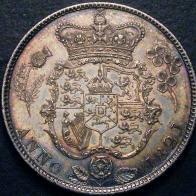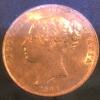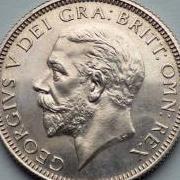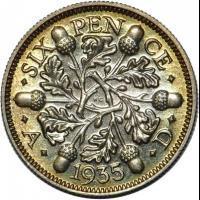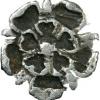Leaderboard
Popular Content
Showing content with the highest reputation on 02/04/2018 in all areas
-
4 points
-
3 points
-
2P Articles and Chronology The first report of 2p varieties occurs in David Sealy’s Coin Varieties column, COINS, July 1971. “Amazingly enough it has taken until now for anyone to come up with any variation in the new decimal 'coppers'. first generally released in February. J. C. Thompson writes from Berwick-upon-Tweed that there are two varieties of the 2p now in circulation, both common, which differ from the coins included in the sets issued earlier. Rev. A (as issued in the 1968 sets): Within those parts of the three crosses which join them to the band of the coronet, incuse lines follow their respective curves, forming triangles. There are also two incuse lines, above and below the five jewels on the band. Rev. B (as issued on D Day); Similar, but the triangles are much reduced in size and less clear, and there are no lines above and below the jewels. Rev. C (as issued on D Day): Similar, but there have been retouches to the turned-over tops of the plumes in the form of incuse lines, especially on the left, where the tip of the quill is now represented by two incuse lines which do not meet-this has the effect of making it point almost vertically downwards instead of slightly to the left. A is scarce and seems to be confined to the sets; in circulation C is perhaps a little commoner than B.” The next report also in COINS, October 1973, and also in David Sealy’s Coin Varieties column. “Another very interesting item, for which I am also indebted to Mr Sturgess, is in the current 1971-dated 2p. It will be remembered that in July 1971 (p. 18: see also 1973 Coins Market Values, p. 85) we described three varieties of this coin discovered by J. C. Thompson. We now have a fourth (Reverse D), most closely resembling Reverse C, but in which the incuse lines on the turned-over ends of the central and left plumes are quite different. In Reverse C the fourth and fifth incuse lines from the right on the top of the left plume meet; in Reverse D they do not, and further to their left an incuse line runs more-or-less vertically right across the tip (see illustration). The type seems to be rare: Mr Sturgess only found the one specimen, in circulation. “ The next entry of interest from the December 1973 issue of COINS is an advert from the Royal Mint for the new 1971 Proof Set of 1971 Decimal coins. “Our first decimal coins the complete 1971 proof set for £3·25.” The next detail of note is the announcement of a series of proof sets for 1972 through to 1976. This appeared in the March 1976 edition of Coins and Medals and also in the March 1976 edition of Coin Monthly. “Prices for the sets, inclusive of postage and packing, are £6.75 for the 1972 set and £5.25 each for the 1973, 1974, 1975 and 1976 sets. The 1972 through to 1975 sets were available immediately and the 1976 later in the year.” A letter to the editor from E.B Mackenzie in Coin Monthly July 1978 “I bought two Proof sets of 1972 decimals for some reason-though only one set of each of the others. I found that, on comparing the two '72 sets, all the' coins except the crowns and the .02 pennies had different reverses. So, every 1972 Proof coin, except crown and .02 penny, has two different reverse types. Interesting.” A follow up letter to the editor from E.B Mackenzie in Coin Monthly January 1979 referring back to his earlier letter. “I had an interesting letter of explanation from the Royal Mint, referring to the 1972 Proofs, and I presume that the same explanation could account for the different reverses of the. other years in question. It was pointed out that, 'during the course of production of the 1972 sets, new reverse tools were made for all denominations except the 25p. In the case of the 2p, the new tools were available so early that it may be that all tbe 2p Proofs were the same type.' The new reverse tools referred to were punches and matrices, from which new dies were sunk.” A further letter to the editor from E.B Mackenzie in Coin Monthly March 1979 expounds on all the coins in the proof sets. With regard to 2 pence coins: “Twopence 1971 the upright of E of NEW points to a space between border beads 1972 the upright of E of NEW points to a border bead 1973-75 both types 1976-78 the upright of E of NEW points to a border bead” And “The only coin out of pattern is the 1972 2 pence. I have not found the reverse with the upright of E of NEW pointing to a space between border beads, but I feel it MUST exist. The Royal Mint has said that 'new reverse tools were made during the production of 1972 Proofs, but in the case of the TWO PENCE the new tools were available so early it may be that all the two pence Proofs were of the same type'. But why then revert to the old type dies in 1973 to 1975, when both types were produced?” The first major article on two pence varieties was E B Mackenzie published in COIN on the 30th November 1979, The Plumes on your Pence. This follows on from his earlier letters and describes seven reverse varieties and four different obverses. Reverses A-D are the same as those posted earlier in COINS, July ’71 and Oct ’73. Reverses A-E and G are all minor varieties relating to changes in the left and central plumes and details on the coronet (and in the final article by Ron Stafford published in September 1987 are all referred to as Reverse A). Reverse F is the only other major reverse variety and is later referred to as reverse B. The 25 Jan-7 Feb 1980 edition of COIN (formerly Coin Monthly) has an article “Decimal Bronze ½, 1 & 2 Pence Varieties 1971-79” by Iain W P Dracott, K B Wiles and Ron Stafford. This expands on the previous article by E B Mackenzie adding slightly more detail. A Correction and addendum to this article from Iain Dracott was made in the 7 Mar-20 Mar 1980 Coin. The October 1984 issue of COIN MONTHLY (formerly COIN) sees Iain WP Dracott’s “Addendum to Decimal Bronze”. This article formalises and reclassifies the various Obverses and Reverses giving die pairing for both circulation and proof coins and mention is made of the BU specimen sets that were introduced in 1982. The final major article on UK decimal coinage is Ron Stafford’s “Coin Varieties: Latest Discoveries” in the July through October 1987 editions of Coin Monthly. This series summarises and in some cases reclassifies all previous published data and truly forms the basis for all future studies. It is his Sept 1987 article which forms the basis of my own studies. I have retained his classifications for dates up to 1986 and extended them with my own data through to the final “Ironside” 2 pence (type 13E, plume 9) in 2008. The last article of any kind is Patrick MacKenzies’s The 1990 UK Circulation Coinage in the April 191 edition of Coin Monthly, wherein he discusses the then new trend of the Royal Mint issuing coins in sets with slight differences to those in circulation! One final point that needs noting is the size of the boarder beads varies some what with those in the sets being generally smaller and further from the rim than the circulation issues. Its very easy to convince yourself that there are variations in bead size and position on the circulation issues, but I believe its an illusion and I can never see them the following morning! Decimal 2 pence Obverses and Reverses Obverse 1 (1) 139 bb. (2) 1 in 19 lt bb. (3) A in ELIZA to sp. (4) E in ELIZ to sp. Obverse 2 (1) 139 bb. (2) 1 in 19 to bb. (3) A in ELIZA to bb. (4) E in ELIZ to bb. Obverse 3 (1) 135 bb. (2) 1 in 19 lt bb. (3) A in ELIZA to bb. (4) E in ELIZ to sp. Obverse 4 (1) 136 bb. (2) 1 in 19 lt bb. (3) A of ELIZABETH to sp. (4) E in ELIZ to sp. Obverse 5 (1) 136 bb (2) 1 in 19 rt bb. (3) As obverse 4 except that the date has been moved Obverse 6 (1) 136 bb. (2) D to bb (3) R to sp (4) 1 of 19 lt bb. (5) I in ELIZ rt bb (6) A to sp (7) 1st I of II to bb. Obverse 7 (1) 135 bb. (2) D rt bb (3) R to bb (4) 1 of 19 to bb. (5) I in ELIZ to bb (6) A rt bb (7) 1st I of II rt bb. Obverse 8 (1) 135 bb. (2) D lt bb (3) R rt bb (4) 1 of 19 rt bb. (5) I in ELIZ to sp (6) A to sp (7) 1st I of II sl bb. Obverse 9 (1) 136 bb. (2) D to sp (3) R rt bb (4) 1 of 19 rt bb. (5) I in ELIZ to bb (6) A rt bb (7) 1st I of II lt bb. Obverse 10 (1) 135 bb. (2) D sr bb (3) R sl bb (4) 1 of 19 to bb. (5) I in ELIZ rt bb (6) A to sp (7) 1st I of II lt bb. Obverse 11 (1) 135 bb. (2) D lt bb (3) R sr bb (4) 1 of 19 sr bb. (5) I in ELIZ sl bb (6) A to bb (7) 1st I of II to bb. Obverse 12 (1) 133 bb. (2) R to bb (3) F to bb (4) 1 of 19 to bb. (5) I in ELIZ sr bb (6) E to bb (7) 1st I of II sl bb. Obverse 13 (1) 132 bb. (2) R to sp (3) F lt bb (4) D sr bb. (5) I in ELIZ lt bb (6) E lt bb (7) 1st I of II sr bb Reverse A (1) 142 bb. (2) L Leg of N in PENCE to bb. (3) E in NCE to bb. Reverse B (1) 139 bb. (2) L Leg of N in PENCE to sp. (3) E in NCE to sp. Reverse C (1) 135 bb. (2) P in PENCE to sp. (3) 1st leg of N lt bb (4) E sr bb (5) T sr bb (6) W to sp. (7) Legend reads TWO PENCE Reverse D (1) 135 bb. (2) P in PENCE rt bb. (3) 1st leg of N to sp (4) E to bb (5) T sr bb (6) W rt bb. Reverse E (1) 134 bb. (2) P in PENCE lt bb. (3) 1st leg of N rt bb (4) E to bb (5) T to sp (6) W to bb. The Plumes on your Two Pence E.B.Mackenzie gave each Reverse with a different plume/coronet a unique letter and he also gave each plume a unique number as follows: Reverse Plume A 1 B 1 C 2 D 3 E 4 F 5 G 1 H 6 I 7 Reverses H and I were added by Iain WP Dracott and I allocated them plume numbers Please note that from 1987 onwards, Reverses A-E and G-H become Rev A, Reverse F becomes B and Reverse I becomes C. Summary of Die Combernations Nb; The lower case letter or number following the Reverse letter is the old pre ’87 reverse or later plume number that I have allocated. Circulation 1971 - 1Aa,b,c,d 1972-1974 - None minted 1975 - 1Ad and 1Bf scarce 1976 - 1lAe and 1Bf fairly scarce 1977 - 2Ae,g 1978 - 4Ag 1979 - 4Ag,h 1980 - 4Ae,g,h and 4Bf very scarce 1981 - 4Ag,h 1982-1984 - None minted 1985 - 6Ci 1986-1988 - 8Ci 1989 - 10Ci 1990-1991 - 8Ci 1992 - 8Ci and 8D10 1993 - 10Ci and 10D10 and 11Ci 1994 - 8D12 1995-1996 - 10D12 1997 - 8D12 1998 - 12D12 Bronze and Cps 1999 - 12D12 2000-2001 - 13D12 2001-2008 - 13D10 Bfdc set 1971 1Aa BU sets 1982-1983 - 4Ci 1984 - 5Ci 1985 - 6Ci 1986 - 7Ci 1987 - 8Ci 1988 - 9Ci 1989-1990 - 10C8 1991-1992 - 10D9 1993-1994 - 10D11 1995 - 10D9 1996 - 10D11 1997 - 10D9 1998-1999 – 12D9 2000-2003 – 13D9 2004-2008 – 13E9 Proof sets 1971 - 1Ad 1972-1975 - 1Ae and 1Bf 1976 - 1Bf 1977 - 3Bf 1978 - 3Bf, scarcer, and 4Bf 1979-1981 - 4Bf 1982-1983 - 4Ci 1984 - 5Ci 1985 - 6Ci 1986 - 7Ci 1987 - 8Ci 1988 - 9Ci 1989 - 10Ci 1990-1992 - 10D9 1993-1994 - 10D11 1995-1997 - 10D9 1998-1999 – 12D9 2000-2003 – 13D9 2004-2008 – 13E9 I will add annotated pictures of the varieties and plumes soon.2 points
-
Ah maybe this is how: https://www.ebay.co.uk/itm/1869-Penny-In-Descent-Grade/263444882950?hash=item3d5689e606:g:XvgAAOSwvflZR~~n2 points
-
https://www.ebay.co.uk/itm/collection-of-one-penny-coins-3/162886713502?hash=item25ecce009e:g:Aa4AAOSw1RVaZNDm2 points
-
2 points
-
2P Articles and Chronology The first report of 2p varieties occurs in David Sealy’s Coin Varieties column, COINS, July 1971. “Amazingly enough it has taken until now for anyone to come up with any variation in the new decimal 'coppers'. first generally released in February. J. C. Thompson writes from Berwick-upon-Tweed that there are two varieties of the 2p now in circulation, both common, which differ from the coins included in the sets issued earlier. Rev. A (as issued in the 1968 sets): Within those parts of the three crosses which join them to the band of the coronet, incuse lines follow their respective curves, forming triangles. There are also two incuse lines, above and below the five jewels on the band. Rev. B (as issued on D Day); Similar, but the triangles are much reduced in size and less clear, and there are no lines above and below the jewels. Rev. C (as issued on D Day): Similar, but there have been retouches to the turned-over tops of the plumes in the form of incuse lines, especially on the left, where the tip of the quill is now represented by two incuse lines which do not meet-this has the effect of making it point almost vertically downwards instead of slightly to the left. A is scarce and seems to be confined to the sets; in circulation C is perhaps a little commoner than B.” The next report also in COINS, October 1973, and also in David Sealy’s Coin Varieties column. “Another very interesting item, for which I am also indebted to Mr Sturgess, is in the current 1971-dated 2p. It will be remembered that in July 1971 (p. 18: see also 1973 Coins Market Values, p. 85) we described three varieties of this coin discovered by J. C. Thompson. We now have a fourth (Reverse D), most closely resembling Reverse C, but in which the incuse lines on the turned-over ends of the central and left plumes are quite different. In Reverse C the fourth and fifth incuse lines from the right on the top of the left plume meet; in Reverse D they do not, and further to their left an incuse line runs more-or-less vertically right across the tip (see illustration). The type seems to be rare: Mr Sturgess only found the one specimen, in circulation. “ The next entry of interest from the December 1973 issue of COINS is an advert from the Royal Mint for the new 1971 Proof Set of 1971 Decimal coins. “Our first decimal coins the complete 1971 proof set for £3·25.” The next detail of note is the announcement of a series of proof sets for 1972 through to 1976. This appeared in the March 1976 edition of Coins and Medals and also in the March 1976 edition of Coin Monthly. “Prices for the sets, inclusive of postage and packing, are £6.75 for the 1972 set and £5.25 each for the 1973, 1974, 1975 and 1976 sets. The 1972 through to 1975 sets were available immediately and the 1976 later in the year.” A letter to the editor from E.B Mackenzie in Coin Monthly July 1978 “I bought two Proof sets of 1972 decimals for some reason-though only one set of each of the others. I found that, on comparing the two '72 sets, all the' coins except the crowns and the .02 pennies had different reverses. So, every 1972 Proof coin, except crown and .02 penny, has two different reverse types. Interesting.” A follow up letter to the editor from E.B Mackenzie in Coin Monthly January 1979 referring back to his earlier letter. “I had an interesting letter of explanation from the Royal Mint, referring to the 1972 Proofs, and I presume that the same explanation could account for the different reverses of the. other years in question. It was pointed out that, 'during the course of production of the 1972 sets, new reverse tools were made for all denominations except the 25p. In the case of the 2p, the new tools were available so early that it may be that all tbe 2p Proofs were the same type.' The new reverse tools referred to were punches and matrices, from which new dies were sunk.” A further letter to the editor from E.B Mackenzie in Coin Monthly March 1979 expounds on all the coins in the proof sets. With regard to 2 pence coins: “Twopence 1971 the upright of E of NEW points to a space between border beads 1972 the upright of E of NEW points to a border bead 1973-75 both types 1976-78 the upright of E of NEW points to a border bead” And “The only coin out of pattern is the 1972 2 pence. I have not found the reverse with the upright of E of NEW pointing to a space between border beads, but I feel it MUST exist. The Royal Mint has said that 'new reverse tools were made during the production of 1972 Proofs, but in the case of the TWO PENCE the new tools were available so early it may be that all the two pence Proofs were of the same type'. But why then revert to the old type dies in 1973 to 1975, when both types were produced?” The first major article on two pence varieties was E B Mackenzie published in COIN on the 30th November 1979, The Plumes on your Pence. This follows on from his earlier letters and describes seven reverse varieties and four different obverses. Reverses A-D are the same as those posted earlier in COINS, July ’71 and Oct ’73. Reverses A-E and G are all minor varieties relating to changes in the left and central plumes and details on the coronet (and in the final article by Ron Stafford published in September 1987 are all referred to as Reverse A). Reverse F is the only other major reverse variety and is later referred to as reverse B. The 25 Jan-7 Feb 1980 edition of COIN (formerly Coin Monthly) has an article “Decimal Bronze ½, 1 & 2 Pence Varieties 1971-79” by Iain W P Dracott, K B Wiles and Ron Stafford. This expands on the previous article by E B Mackenzie adding slightly more detail. A Correction and addendum to this article from Iain Dracott was made in the 7 Mar-20 Mar 1980 Coin. The October 1984 issue of COIN MONTHLY (formerly COIN) sees Iain WP Dracott’s “Addendum to Decimal Bronze”. This article formalises and reclassifies the various Obverses and Reverses giving die pairing for both circulation and proof coins and mention is made of the BU specimen sets that were introduced in 1982. The final major article on UK decimal coinage is Ron Stafford’s “Coin Varieties: Latest Discoveries” in the July through October 1987 editions of Coin Monthly. This series summarises and in some cases reclassifies all previous published data and truly forms the basis for all future studies. It is his Sept 1987 article which forms the basis of my own studies. I have retained his classifications for dates up to 1986 and extended them with my own data through to the final “Ironside” 2 pence (type 13E, plume 9) in 2008. The last article of any kind is Patrick MacKenzies’s The 1990 UK Circulation Coinage in the April 191 edition of Coin Monthly, wherein he discusses the then new trend of the Royal Mint issuing coins in sets with slight differences to those in circulation! One final point that needs noting is the size of the boarder beads varies some what with those in the sets being generally smaller and further from the rim than the circulation issues. Its very easy to convince yourself that there are variations in bead size and position on the circulation issues, but I believe its an illusion and I can never see them the following morning! Decimal 2 pence Obverses and Reverses Obverse 1 (1) 139 bb. (2) 1 in 19 lt bb. (3) A in ELIZA to sp. (4) E in ELIZ to sp. Obverse 2 (1) 139 bb. (2) 1 in 19 to bb. (3) A in ELIZA to bb. (4) E in ELIZ to bb. Obverse 3 (1) 135 bb. (2) 1 in 19 lt bb. (3) A in ELIZA to bb. (4) E in ELIZ to sp. Obverse 4 (1) 136 bb. (2) 1 in 19 lt bb. (3) A of ELIZABETH to sp. (4) E in ELIZ to sp. Obverse 5 (1) 136 bb (2) 1 in 19 rt bb. (3) As obverse 4 except that the date has been moved Obverse 6 (1) 136 bb. (2) D to bb (3) R to sp (4) 1 of 19 lt bb. (5) I in ELIZ rt bb (6) A to sp (7) 1st I of II to bb. Obverse 7 (1) 135 bb. (2) D rt bb (3) R to bb (4) 1 of 19 to bb. (5) I in ELIZ to bb (6) A rt bb (7) 1st I of II rt bb. Obverse 8 (1) 135 bb. (2) D lt bb (3) R rt bb (4) 1 of 19 rt bb. (5) I in ELIZ to sp (6) A to sp (7) 1st I of II sl bb. Obverse 9 (1) 136 bb. (2) D to sp (3) R rt bb (4) 1 of 19 rt bb. (5) I in ELIZ to bb (6) A rt bb (7) 1st I of II lt bb. Obverse 10 (1) 135 bb. (2) D sr bb (3) R sl bb (4) 1 of 19 to bb. (5) I in ELIZ rt bb (6) A to sp (7) 1st I of II lt bb. Obverse 11 (1) 135 bb. (2) D lt bb (3) R sr bb (4) 1 of 19 sr bb. (5) I in ELIZ sl bb (6) A to bb (7) 1st I of II to bb. Obverse 12 (1) 133 bb. (2) R to bb (3) F to bb (4) 1 of 19 to bb. (5) I in ELIZ sr bb (6) E to bb (7) 1st I of II sl bb. Obverse 13 (1) 132 bb. (2) R to sp (3) F lt bb (4) D sr bb. (5) I in ELIZ lt bb (6) E lt bb (7) 1st I of II sr bb Reverse A (1) 142 bb. (2) L Leg of N in PENCE to bb. (3) E in NCE to bb. Reverse B (1) 139 bb. (2) L Leg of N in PENCE to sp. (3) E in NCE to sp. Reverse C (1) 135 bb. (2) P in PENCE to sp. (3) 1st leg of N lt bb (4) E sr bb (5) T sr bb (6) W to sp. (7) Legend reads TWO PENCE Reverse D (1) 135 bb. (2) P in PENCE rt bb. (3) 1st leg of N to sp (4) E to bb (5) T sr bb (6) W rt bb. Reverse E (1) 134 bb. (2) P in PENCE lt bb. (3) 1st leg of N rt bb (4) E to bb (5) T to sp (6) W to bb. The Plumes on your Two Pence E.B.Mackenzie gave each Reverse with a different plume/coronet a unique letter and he also gave each plume a unique number as follows: Reverse Plume A 1 B 1 C 2 D 3 E 4 F 5 G 1 H 6 I 7 Reverses H and I were added by Iain WP Dracott and I allocated them plume numbers Please note that from 1987 onwards, Reverses A-E and G-H become Rev A, Reverse F becomes B and Reverse I becomes C. Summary of Die Combernations Nb; The lower case letter or number following the Reverse letter is the old pre ’87 reverse or later plume number that I have allocated. Circulation 1971 - 1Aa,b,c,d 1972-1974 - None minted 1975 - 1Ad and 1Bf scarce 1976 - 1lAe and 1Bf fairly scarce 1977 - 2Ae,g 1978 - 4Ag 1979 - 4Ag,h 1980 - 4Ae,g,h and 4Bf very scarce 1981 - 4Ag,h 1982-1984 - None minted 1985 - 6Ci 1986-1988 - 8Ci 1989 - 10Ci 1990-1991 - 8Ci 1992 - 8Ci and 8D10 1993 - 10Ci and 10D10 and 11Ci 1994 - 8D12 1995-1996 - 10D12 1997 - 8D12 1998 - 12D12 Bronze and Cps 1999 - 12D12 2000-2001 - 13D12 2001-2008 - 13D10 Bfdc set 1971 1Aa BU sets 1982-1983 - 4Ci 1984 - 5Ci 1985 - 6Ci 1986 - 7Ci 1987 - 8Ci 1988 - 9Ci 1989-1990 - 10C8 1991-1992 - 10D9 1993-1994 - 10D11 1995 - 10D9 1996 - 10D11 1997 - 10D9 1998-1999 – 12D9 2000-2003 – 13D9 2004-2008 – 13E9 Proof sets 1971 - 1Ad 1972-1975 - 1Ae and 1Bf 1976 - 1Bf 1977 - 3Bf 1978 - 3Bf, scarcer, and 4Bf 1979-1981 - 4Bf 1982-1983 - 4Ci 1984 - 5Ci 1985 - 6Ci 1986 - 7Ci 1987 - 8Ci 1988 - 9Ci 1989 - 10Ci 1990-1992 - 10D9 1993-1994 - 10D11 1995-1997 - 10D9 1998-1999 – 12D9 2000-2003 – 13D9 2004-2008 – 13E91 point
-
The metal alloy used for brazing has a melting point range of 618oC to 899oC. The melting point of pure silver is 962oC. Melting point of sterling would be lower and could be around 893oC . Hence I guess it can be done with care if one is lucky. Might be the restorers will only go up to a certain temperature like 750 or 800 oC and give up if the metal alloy does not start to melt? If the melting point of the metal alloy is very close to the melting point of sterling, then the coin surface underneath has probably already been damaged in the brazing process anyway. We have all seen photos of coins which have stuff successfully removed. But surely there must be a fair number of cases where restoration is impossible.1 point
-
1 point
-
Looks like a grot. Probably a follis of Vespasian I think judging by the profile.1 point
-
the dies have defo had some prep work done or do the early strike definitive show this as well of you catch them early enough ? they even went to the trouble of doing jody clarks initials, £15 isn't so much when you can pay £13 for a base metal £2 coin, least its made of some precious metal lol1 point
-
1 point
-
1 point
-
If you don't already have one, get a yearly price reference, Spink's Coins of England or Collector's Coins (at the top of this page in the advert) will do and it doesn't have to be the latest volume either because all the types available are laid out and rarity pretty much correlates to price. Do the exercise and you will learn as you familiarise yourself with the prices, what constitutes an affordable year. or indeed whether it is possible.1 point
-
"The coins in the slabs go round and round, round and round, round and round; the coins in the slabs go round and round, all day long!"1 point


